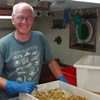General Description
Carapace pear-shaped, strongly narrowing anteriorly, dorsally weakly tuberculate, with hooked setae. Rostral spines subparallel, partially fused. Supraorbital margin comprising eave with rounded preorbital angle, obsolete antorbital spine, intercalated spine, and short conical postorbital spine separated from eave by narrow fissures. Basal antennal article notched before anterolateral angle produced as short crenulate tooth, with short distomesial spine. Walking legs with propodi cylindrical. Up to 3 cm long.
Biology
This species has a characteristic crenulate tooth on the basal antennal article which, together with the shorter rostral spines, distinguishes it from species of Notomithrax.
Habitat
Rocky subtidal reef.
Soft substrates
Reefs
Distribution guide
Southern temperate oceans, including southern Australia.
Species Group
Depth
Water Column
Max Size
3 cm
Diet
Organic matter
Harmful
Not harmful but a nip from large claws could be painful
Commercial Species
No
Global Dispersal
Native to Australia
Conservation Status
- DSE Advisory List : Not listed
- EPBC Act 1999 : Not listed
- IUCN Red List : Not listed








